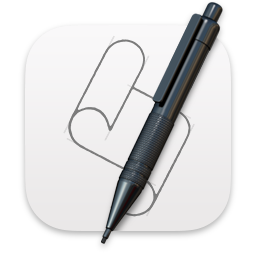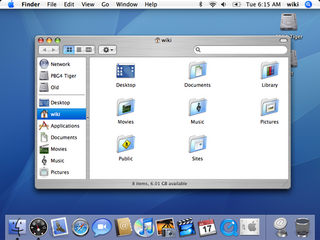macOS is a series of proprietary graphical operating systems developed and marketed by Apple Inc. since 2001. It is the primary operating system for Apple's Mac computers. Within the market of desktop, laptop and home computers, and by web usage, it is the second most widely used desktop OS, after Microsoft Windows.
Cocoa is Apple's native object-oriented application programming interface (API) for its desktop operating system macOS.

AppleScript is a scripting language created by Apple Inc. that facilitates automated control over scriptable Mac applications. First introduced in System 7, it is currently included in all versions of macOS as part of a package of system automation tools. The term "AppleScript" may refer to the language itself, to an individual script written in the language, or, informally, to the macOS Open Scripting Architecture that underlies the language.
The history of macOS, Apple's current Mac operating system originally named Mac OS X until 2012 and then OS X until 2016, began with the company's project to replace its "classic" Mac OS. That system, up to and including its final release Mac OS 9, was a direct descendant of the operating system Apple had used in its Macintosh computers since their introduction in 1984. However, the current macOS is a Unix operating system built on technology that had been developed at NeXT from the 1980s until Apple purchased the company in early 1997.

In computing, configuration files are files used to configure the parameters and initial settings for some computer programs. They are used for user applications, server processes and operating system settings.

Aqua is the graphical user interface, design language and visual theme of Apple's macOS operating system. It was originally based on the theme of water, with droplet-like components and a liberal use of reflection effects and translucency. Its goal is to "incorporate color, depth, translucence, and complex textures into a visually appealing interface" in macOS applications. At its introduction, Steve Jobs noted that "... it's liquid, one of the design goals was when you saw it you wanted to lick it".

Mac OS X 10.0 is the first major release and version of macOS, Apple's desktop and server operating system. Mac OS X 10.0 was released on March 24, 2001 for a price of US$129. It was the successor of the Mac OS X Public Beta and the predecessor of Mac OS X 10.1.

Mac OS X Tiger is the fifth major release of macOS, Apple's desktop and server operating system for Mac computers. Tiger was released to the public on April 29, 2005 for US$129.95 as the successor to Mac OS X 10.3 Panther. Some of the new features included a fast searching system called Spotlight, a new version of the Safari web browser, Dashboard, a new 'Unified' theme, and improved support for 64-bit addressing on Power Mac G5s. Mac OS X 10.4 Tiger offered a number of features, such as fast file searching and improved graphics processing, that Microsoft had spent several years struggling to add to Windows with acceptable performance.
Apple events are the message-based interprocess communication mechanism in Mac OS, first making an appearance in System 7 and supported by every version of the classic Mac OS since then and by macOS. Apple events describe "high-level" events such as "open document" or "print file", whereas earlier OSs had supported much more basic events, namely "click" and "keypress". Apple events form the basis of the Mac OS scripting system, the Open Scripting Architecture.

Terminal (Terminal.app) is the terminal emulator included in the macOS operating system by Apple. Terminal originated in NeXTSTEP and OPENSTEP, the predecessor operating systems of macOS.

Desktop notes are computer applications that allow putting Post-it note-like windows on the screen, with reminders, short notes and other clippings. They are typically rectangular and yellow, like their real-world counterpart, but most applications support other colours and more elaborate designs.
MacApp was Apple Computer's object oriented application framework for the classic Mac OS. Released in 1985, it transitioned from Object Pascal to C++ in 1991's version 3.0 release, which offered support for much of System 7's new functionality. MacApp was used for a variety of major applications, including Adobe Photoshop and SoftPress Freeway. Microsoft's MFC and Borland's OWL were both based directly on MacApp concepts.
The clipboard is a buffer that some operating systems provide for short-term storage and transfer within and between application programs. The clipboard is usually temporary and unnamed, and its contents reside in the computer's RAM. The clipboard is sometimes called the paste buffer.
The Services menu is a user interface element in a computer operating system. The services are programs that accept input from the user selection, process it, and optionally put the result back in the clipboard. The concept originated in the NeXTSTEP operating system, from which it was carried over into macOS and GNUstep. Similar features can be emulated on other operating systems.
In computing, a keyboard shortcut is a sequence or combination of keystrokes on a computer keyboard which invokes commands in software.

The Macintosh "System 1" is the first version of Apple Macintosh operating system and the beginning of the classic Mac OS series. It was developed for the Motorola 68000 microprocessor. System 1 was released on January 24, 1984, along with the Macintosh 128K, the first in the Macintosh family of personal computers. It received one update, "System 1.1" on December 29, 1984, before being succeeded by System 2.

Mac OS X Lion is the eighth major release of macOS, Apple's desktop and server operating system for Macintosh computers.

Launchpad is an application launcher for macOS introduced in Mac OS X Lion. Launchpad is designed to resemble the SpringBoard interface in iOS. The user starts an application by single-clicking its icon. Launchpad provides an alternative way to start applications in macOS, in addition to other options such as the Dock, Finder, Spotlight or Terminal.

macOS Sierra is the thirteenth major release of macOS, Apple Inc.'s desktop and server operating system for Macintosh computers. The name "macOS" stems from the intention to uniform the operating system's name with that of iOS, watchOS and tvOS. Sierra is named after the Sierra Nevada mountain range in California and Nevada. Its major new features concern Continuity, iCloud, and windowing, as well as support for Apple Pay and Siri.













